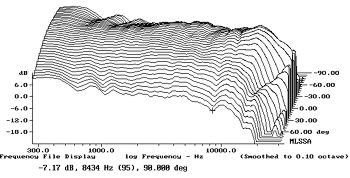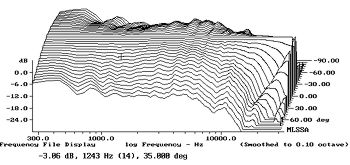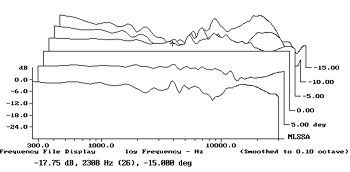| Columns Retired Columns & Blogs |
Dynaudio Evidence Master loudspeaker Measurements part 2
With its narrow width and sensible choice of radiating geometry, the Evidence offers superbly well-controlled lateral dispersion, as can be seen from fig.4 (actual responses) and fig.5 (differences in response). Other than the increasing directivity of the tweeter above 10kHz due to its relatively large diameter (28mm), the Evidence's off-axis behavior is smooth, with no discontinuities, peaks, or dips. Not only will this ensure that the speaker excites the listening room's reverberant field in an uncolored manner, it also guarantees stable, well-defined stereo imaging. Looking at fig.5, there is just a hint of a slightly wider dispersion at the bottom of the tweeter's passband than at the top of the midrange unit's. All things being equal, this will tend to compensate for the slight lack of on-axis energy in the same region.

Fig.4 Dynaudio Evidence, lateral response family at 50", from back to front: responses 90 degrees-5 degrees off-axis, reference response on tweeter axis, responses 5 degrees-90 degrees off-axis.

Fig.5 Dynaudio Evidence, lateral response family at 50", normalized to response on tweeter axis, from back to front: differences in response 90 degrees-5 degrees off-axis, reference response, differences in response 5 degrees-90 degrees off-axis.
Fig.6 shows the manner in which the Dynaudio's response changes as the listener moves above or below the tweeter axis. The balance changes only slightly as the listener moves below the tweeter; for a standing listener, a suckout appears in the crossover region between the midrange units and tweeters.

Fig.6 Dynaudio Evidence, vertical response family at 50", from back to front: differences in response 15 degrees-5 degrees above axis, reference response, differences in response 5 degrees-10 degrees below axis.
- Log in or register to post comments




































